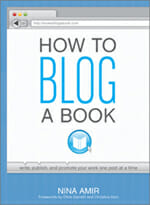by Nina Amir (@NinaAmir)
This post is part of Nina’s blog tour for How to Blog a Book, her terrific and useful new title that’s just been released. Nina is something of an expert on this question, and we’ve engaged in some interesting discussions about the multitude of ways writers can use their blogs. Nina’s last post here was 7 Ways to Mine Blog Posts into Publishable Gold.
I once heard Ellen Archer, president and publisher of Hyperion Books, say the advent of blogs provided publishers for the first time with a way to test market potential books. In other words, a successful blog equals a successfully test marketed book idea.
Why? Publishers consider loyal blog readers and subscribers potential buyers of a book based upon that blog. And the books that have, indeed, been published and contained primarily blogged material have proven this premise correct.
Take, for example, some of the early blog-to-book hits, like Pamela Slim’s Escape from Cubicle Nation: From Corporate Prisoner to Thriving Entrepreneur, which was released in 2009 by Penguin/Portfolio and contains about 70 percent new content and 30 percent blog posts.
Or consider Brett McKay’s The Art of Manliness: Classic Skills and Manners for the Modern Man, published in October 2009 by HOW Books; seventy-five percent of the book consists of articles taken from the blog and edited for the book, and 25 percent of the book’s content is new material.
Then there is Christian Lander’s Stuff White People Like, The Definitive Guide to the Unique Taste of Millions released by Random House Trade Paperbacks in 2008; the book consists of 50 percent new material including charts, graphs, and other work from graphic designers.
More recently, we’ve seen Martha Alderson get a book deal for her blog, The Plot Whisperer, Jill Smokler land one for her blog, Scary Mommy, Dmitry Samarov scoop one up for his blog, Hack, Grace Bonny score one for her blog, Design Sponge, Jill Abramson end up with one for her blog, The Puppy Diaries, and Kevin Cotter win one for his blog, My Ex-Wife’s Wedding Dress. And there are more…
They all share one thing in common: They attracted a large number of readers, and these readers attracted a publisher or at least made the blog attractive to a publisher. Why? For the reason mentioned above. The publisher saw the blog as the closest thing to a sure bet as any proposed book could be.
How to Test Market Your Book
There are two ways to test market your book on a blog. You can simply blog on the topic of your book or you can blog your book. Let’s look at the pros and cons of both.
1. Blogging on the topic of your book. In this case you choose your book’s topic, and then simply begin blogging day and day out on that topic. As you blog you pay attention to the sub-topics that garner the most interest; in other words, you watch your blog statistics to see if you get more readers when you blog about one particular subject over another. You focus on the subjects your readers are interested in, slowly building up a loyal fan base and angling your blog and an eventual book toward your readers’ interests.
Later, when you decide to compile your book, you can focus on the 5-10 areas your readers have shown they want to read about most by creating a content plan for a book based upon their interests. You can “book your blog,” a term coined by Joel Friedlander, by repurposing old posts into a book. You do this by choosing relevant posts and placing them into a manuscript.
2. Blogging a book. With this option you choose a topic for your book, create a content plan, and then break each chapter into post-sized bits (250-500 words). You then compose those posts in a word processing program on a schedule (2-7 times per week) so you create a manuscript, copying and pasting them into your blogging program on a regular schedule as you complete them. You watch your analytics program to see if your readership grows and if any particular parts of the book are not of interest to your readers or if certain “chapters” are of more interest.
However, you are most concerned with seeing if the book as a whole—the general topic of your book—will garner a loyal and large readership over time. If so, you can simply edit and revise the manuscript you have created and submit it to a publisher along with a book proposal—if a publisher does not find you in the process of blogging your book.
Of theses two choices, the second is by far the most logical. Blogging a book is the fastest and easiest way to write a book and discover if it has a market—readers—because you promote your book at the same time that you write. You create an author’s platform—a built in readership—as you blog your book. Plus, you create a manuscript, so you don’t have to go back and search out content and make it fit into the content plan for a book after the fact.
What To Do When You Finish Your Test Marketing Project
 If your test marketing project doesn’t work, you have a few choices. You can just delete your blog and all the content on it. I don’t suggest this. Here are some other choices:
If your test marketing project doesn’t work, you have a few choices. You can just delete your blog and all the content on it. I don’t suggest this. Here are some other choices:
- Create an ebook and give it away for free to build your mailing list or simply to help yourself get known. More than likely, you gathered at least a small number of readers around your blog. That means someone is interested in your topic. Someone will want to read the book.
- You can look at the posts that were most popular and focus on them. Create a content plan around those topics and begin blogging a new book on the same blog. Don’t let those readers you attracted go to waste.
- You can simply keep blogging and build you blog into a nice platform for yourself. Blog on the topics your readers showed interest in. Later blog a new book when you have another idea or find a hot topic.
- Submit a proposal to a publisher. If you simply didn’t build up enough readers to get discovered by a publisher by the time you finished blogging your book but your readership is growing nicely, send a query letter and a proposal off to a publisher. If you believe you have a good idea, move forward. That’s what I did with my blogged book, How to Blog a Book, and I ended up with a publisher and a blook, a book based on a blog. Of course, you can also just self-publish, which is a fabulous option if you have a strong fan base for your blog as well.
 Nina Amir, Inspiration-to-Creation Coach, inspires people to combine their purpose and passion so they Achieve More Inspired Results. She motivates both writers and non-writers to create publishable and published products, careers as authors and to achieve their goals and fulfill their purpose.
Nina Amir, Inspiration-to-Creation Coach, inspires people to combine their purpose and passion so they Achieve More Inspired Results. She motivates both writers and non-writers to create publishable and published products, careers as authors and to achieve their goals and fulfill their purpose.
The author of How to Blog a Book, Write, Publish and Promote Your Work One Post at a Time (Writer’s Digest Books), Nina has also self-published 10 short books and is a sought after editor, proposal consultant, book and author coach, and blog-to-book coach. The founder of Write Nonfiction in November, she writes four blogs, including Write Nonfiction NOW!, How to Blog a Book and As the Spirit Moves Me.
Amazon links are affiliate links. Blog header photo by notionscapital

